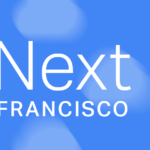Google’s hybrid cloud platform is coming to AWS and Azure
Google’s Cloud Services Platform for managing hybrid clouds that span on-premise data centers and the Google cloud is coming out of beta today. The company is also changing the product’s name to Anthos, a name that either refers to a lost Greek tragedy, the name of an obscure god in the Marvel universe or rosemary. That by itself would be interesting, but minor news. What makes this interesting is that Google also today announced that Anthos will run on third-party clouds, as well, including AWS and Azure.
“We will support Anthos and AWS and Azure as well, so people get one way to manage their application and that one way works across their on-premise environments and all other clouds,” Google’s senior VP for its technical infrastructure, Urs Hölzle, explained in a press conference ahead of today’s announcement.
So with Anthos, Google will offer a single managed service that will let you manage and deploy workloads across clouds, all without having to worry about the different environments and APIs. That’s a big deal and one that clearly delineates Google’s approach from its competitors’. This is Google, after all, managing your applications for you on AWS and Azure.
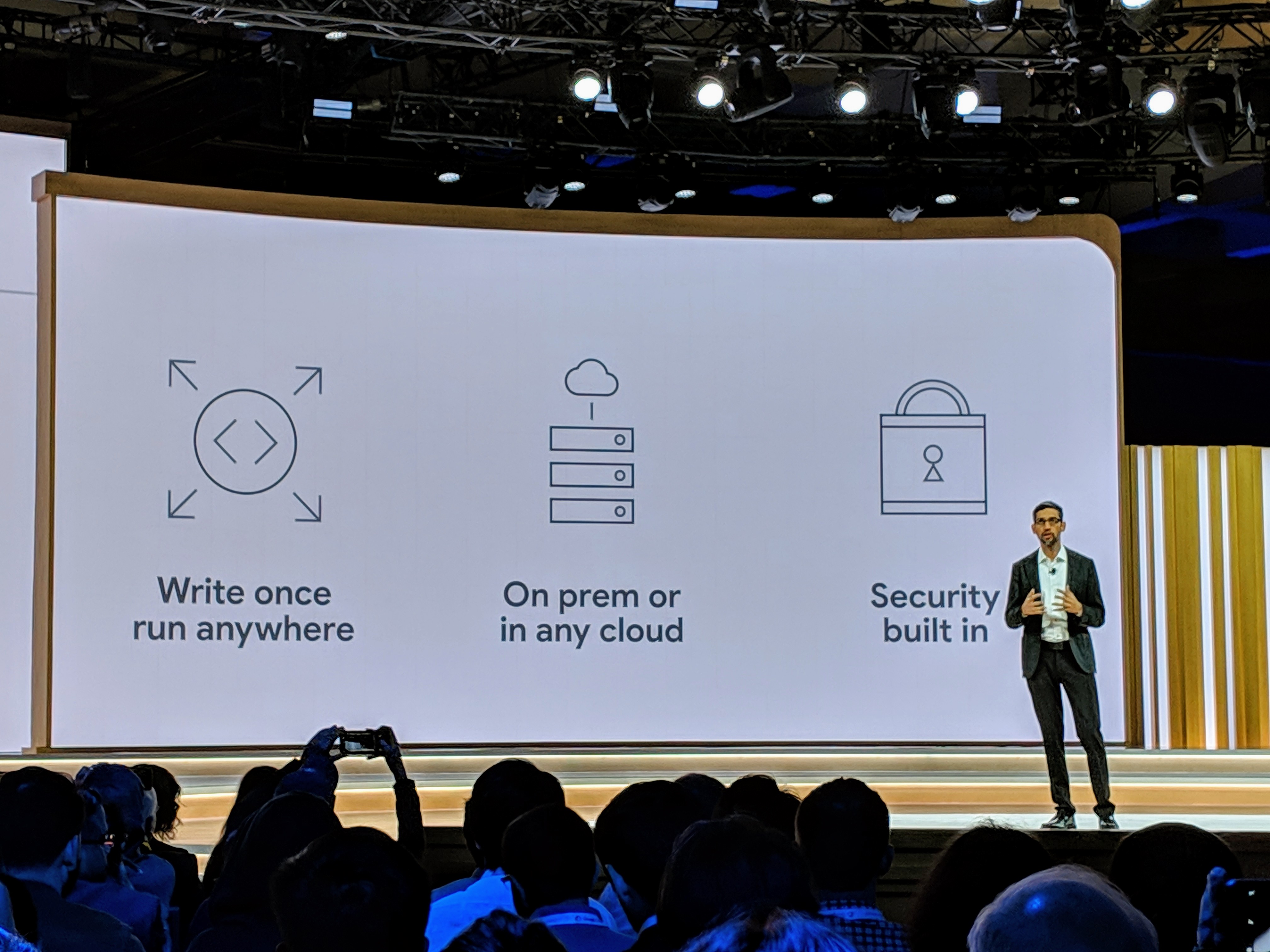
“You can use one consistent approach — one open-source based approach — across all environments,” Hölzle said. “I can’t really stress how big a change that is in the industry, because this is really the stack for the next 20 years, meaning that it’s not really about the three different clouds that are all randomly different in small ways. This is the way that makes these three cloud — and actually on-premise environments, too — look the same.”
Anthos/Google Cloud Services Platform is based on the Google Kubernetes Engine, as well as other open-source projects like the Istio service mesh. It’s also hardware agnostic, meaning that users can take their current hardware and run the service on top of that without having to immediately invest in new servers.
Why is Google doing this? “We hear from our customers that multi-cloud and hybrid is really an acute pain point,” Hölzle said. He noted that containers are the enabling technology for this but that few enterprises have developed a unifying strategy to manage these deployments and that it takes expertise in all major clouds to get the most out of them.
Enterprises already have major investments in their infrastructure and created relationships with their vendors, though, so it’s no surprise that Google is launching Anthos with more than 30 major hardware and software partners that range from Cisco to Dell EMC, HPE and VMware, as well as application vendors like Confluent, Datastax, Elastic, Portworx, Tigera, Splunk, GitLab, MongoDB and others.
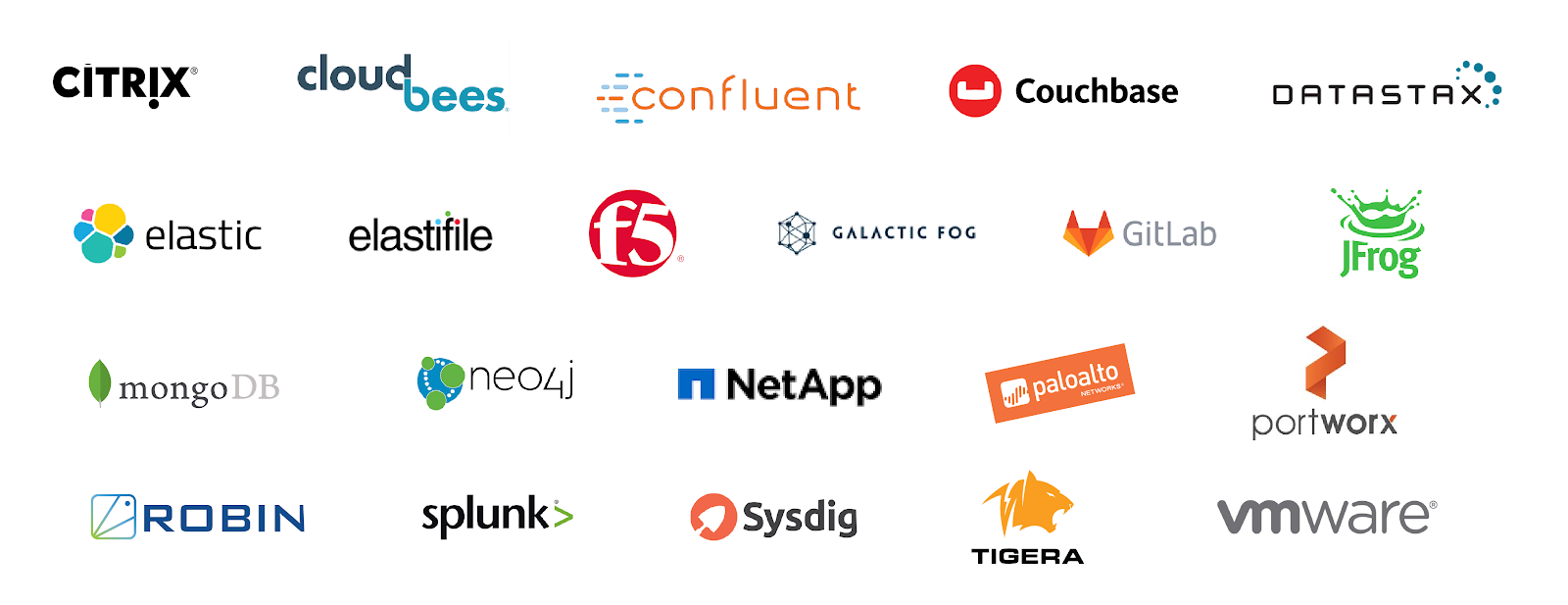
Robin.io, a data management service that offers a hyper-converged storage platform based on Kubernetes, also tells me that it worked closely with Google to develop the Anthos Storage API. “Robin Storage offers bare metal performance, powerful data management capabilities and Kubernetes-native management to support running enterprise applications on Google Cloud’s Anthos across on-premises data centers and the cloud,” said Premal Buch, CEO of Robin.io.
Anthos is a subscription-based service, with the list prices starting at $10,000/month per 100 vCPU block. Enterprise prices will then be up for negotiation, though, so many customers will likely pay less.
It’s one thing to use a service like this for new applications, but many enterprises already have plenty of line-of-business tools that they would like to bring to the cloud as well. For them, Google is launching the first beta of Anthos Migrate today. This service will auto-migrate VMs from on-premises or other clouds into containers in the Google Kubernetes Engine. The promise here is that this is essentially an automatic process and once the container is on Google’s platform, you’ll be able to use all of the other features that come with the Anthos platform, too.
Google’s Hölzle noted that the emphasis here was on making this migration as easy as possible. “There’s no manual effort there,” he said.
Powered by WPeMatico
Google Cloud is bringing two new data centers online in 2020
At Google Cloud Next today, the company announced it is bringing two brand new data centers online in the 2020 time frame, with one in Seoul, South Korea and one in Salt Lake City, Utah.
The company, like many of its web scale peers, has had the data center building pedal to the metal over the last several years. It has grown to 15 regions, with each region hosting multiple zones for a total of 45 zones. In all, the company has a presence in 13 countries and says it has invested an impressive $47 billion (with a B) of CAPEX investment from 2016-2018.

Google Data Center Map. Photo: Google
“We’re going to be announcing the availability in early 2020 of Seoul, South Korea. So we are announcing a region there with three zones for customers to build their applications. Again, customers, either multinationals that are looking to serve their customers in that market or local customers that are looking to go global. This really helps address their needs and allows them to serve the customers in the way that they want to,” Dominic Preuss, director of product management said.
He added, “Similarly, Salt Lake City is our third region in the western United States along with Oregon and Los Angeles. And so it allows developers to build distributed applications across multiple regions in the western United States.”
In addition, the company announced that its new data center in Osaka, Japan is expected to come online some time in the coming weeks. One in Jakarta, Indonesia, currently under construction, is expected to come online the first half of next year.
Powered by WPeMatico
Google Cloud Run brings serverless and containers together
Two of the biggest trends in applications development in recent years have been the rise of serverless and containerization. Today at Google Cloud Next, the company announced a new product called Cloud Run that is designed to bring the two together. At the same time, the company also announced Cloud Run for GKE, which is specifically designed to run on Google’s version of Kubernetes.
Oren Teich, director of product management for serverless, says these products came out of discussions with customers. As he points out, developers like the flexibility and agility they get using serverless architecture, but have been looking for more than just compute resources. They want to get access to the full stack, and to that end the company is announcing Cloud Run.
“Cloud Run is introducing a brand new product that takes Docker containers and instantly gives you a URL. This is completely unique in the industry. We’re taking care of everything from the top end of SSL provisioning and routing, all the way down to actually running the container for you. You pay only by the hundred milliseconds of what you need to use, and it’s end-to-end managed,” Teich explained.
As for the GKE tool, it provides the same kinds of benefits, except for developers running their containers on Google’s GKE version of Kubernetes. Keep in mind, developers could be using any version of Kubernetes their organizations happen to have chosen, so it’s not a given that they will be using Google’s flavor of Kubernetes.
“What this means is that a developer can take the exact same experience, the exact same code they’ve written — and they have G Cloud command line, the same UI and our console and they can just with one-click target the destination they want,” he said.
All of this is made possible through yet another open-source project the company introduced last year called Knative. “Cloud Run is based on Knative, an open API and runtime environment that lets you run your serverless workloads anywhere you choose — fully managed on Google Cloud Platform, on your GKE cluster or on your own self-managed Kubernetes cluster,” Teich and Eyal Manor, VP of engineering, wrote in a blog post introducing Cloud Run.
Serverless, as you probably know by now, is a bit of a misnomer. It’s not really taking away servers, but it is eliminating the need for developers to worry about them. Instead of loading their application on a particular virtual machine, the cloud provider, in this case, Google, provisions the exact level of resources required to run an operation. Once that’s done, these resources go away, so you only pay for what you use at any given moment.
Powered by WPeMatico
Slack integration with Office 365 one more step toward total enterprise integration
Slack’s goal of integrating enterprise tools in the chat interface has been a major differentiator from the giant companies it’s competing with like Microsoft and Facebook. Last year, it bought Astro, specifically with the goal of integrating enterprise productivity tools inside Slack, and today it announced new integrations with Microsoft OneDrive and Outlook.
Specifically, Slack is integrating calendar, files and calls and bringing in integrations with other services, including Box, Dropbox and Zoom.
Andy Pflaum, director of project management at Slack, came over in the Astro deal, and he says one of the primary goals of the acquisition was to help build connections like this to Microsoft and Google productivity tools.
“When we joined Slack, it was to build out the interoperability between Slack and Microsoft’s products, particularly Office and Office 365 products, and the comparable products from Google, G Suite. We focused on deep integration with mail and calendar in Slack, as well as bringing in files and calls in from Microsoft, Google and other leading providers like Zoom, Box and Dropbox,” Pflaum, who was co-founder and CEO at Astro, told TechCrunch.
For starters, the company is announcing deep integration with Outlook that enables users to get and respond to invitations in Slack. You can also join a meeting with a click directly from Slack, whether that’s Zoom, WebEx or Skype for Business. What’s more, when you’re in a meeting, your status will update automatically in Slack, saving users from manually doing this (or more likely forgetting and getting a flurry of Slack questions in the middle of a meeting).

Another integration lets you share emails directly into Slack. Instead of copying and pasting or forwarding the email to a large group, you can click a Slack button in the Outlook interface and share it as a direct message with a group or to your personal Slack channel.
File sharing is not being left behind here either, whether from Microsoft, Box or Dropbox; users will be able to share files inside of Slack easily. Finally, users will be able to view full Office document previews inside of Slack, another step in avoiding tasking switching to get work done.
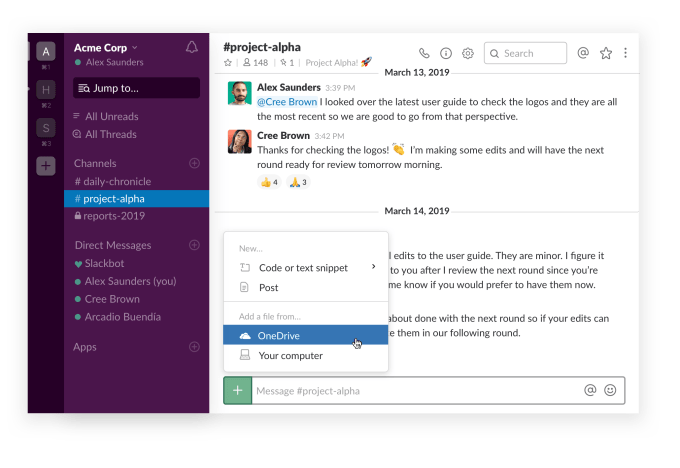
Screenshot: Slack
Mike Gotta, an analyst at Gartner who has been following the collaboration space for many years, says the integration has done a good job of preserving the user experience, while allowing for a seamless connection between email, calendar and files. He says that this could give them an edge in the highly competitive collaboration market, and more importantly allow users to maintain context.
“The collaboration market is highly fragmented with many vendors adding ‘just a little’ collaboration to products designed for specific purposes. Buyers can find that this type of collaboration in context to the flow of work is more impactful than switching to a generalized tool that lacks situational awareness of the task at hand. Knowledge-based work often involves process and project-related applications, so the more we can handle transitions across tools, the more productive the user experience becomes. More importantly there’s less context fragmentation for the individual and team,” Gotta told TechCrunch.
These updates are about staying one step ahead of the competition, and being able to run Microsoft tools inside of Slack gives customers another reason to stick with (or to buy) Slack instead of Microsoft’s competing product, Teams.
All of this new functionality is designed to work in both mobile and desktop versions of the product and is available today.
Powered by WPeMatico
Dote raises $12M and introduces live-streamed Shopping Parties
Mobile shopping startup Dote is announcing $12 million in new funding, as well as a new feature called Shopping Party.
Founder and CEO Lauren Farleigh said her initial goal was to create “a truly native mobile experience” that made it “easy to check out across a lot of different stores.”
Over time, recommendations from social media influencers have become a big part of the app. With Shopping Party, they’re taking center stage — the feature allows them to share live video while browsing different products on Dote and chatting with fans.
Farleigh said the idea came from a trip she took with Dote influencers to Fiji last fall. She described watching them shop and talk together at the airport, and in what she said was an “ah-ha moment,” she realized that there’s an experience that was “lost when we stopped going to the mall with our friends.”
She added that influencers embraced the idea, with some telling her, “We love going live on Instagram [but] it’s challenging because there’s no shared experience for us to have that meaningful interaction over. It usually turns into the same Q&A over and over again.”

Dote CEO Lauren Farleigh
Shopping Party offers one solution to that issue, because you’re actually browsing and talking about specific products in the Dote app. Apparently this was a real technical challenge — Shopping Party is leveraging Apple’s ReplayKit 2 framework to deliver two live streams (one from the phone camera, one from the Dote app) while also incorporating live chats.
Farleigh, who previously worked as a product manager at mobile gaming company Pocket Gems, also compared this to game streaming on Twitch, except for shopping.
To kick things off, Dote plans to host two Shopping Parties every hour from 6am to 10am Pacific time for the next two weeks. (The company says the average Shopping Party lasts about 15 minutes.) There also will be Shopping Parties sponsored by specific brands.
As for the funding, it was led by Goodwater Capital, with participation from Lightspeed Venture Partners and Harrison Metal. Dote has now raised a total of $23 million.
“[Dote’s] customer-centric shopping platform uniquely blends innovative technologies such as live-streaming with relevant and fun social features, setting the standard for how all major brands and retailers will connect with Gen Z,” said Goodwater Managing Partner Eric Kim in a statement. “We’re thrilled to partner with them to accelerate this transformation.”
Powered by WPeMatico
PubNub nabs $23M as its IaaS network hits 1.3T messages sent each month
There’s been a huge increase in the last decade of applications and services that rely on real-time notifications and other alerts as a core part of how they operate, and today one of the companies that powers those notifications is announcing a growth round. PubNub — an infrastructure-as-a-service provider that provides a real-time network to send and manage messaging traffic between companies, between companies and apps and between internet-of-things devices — has raised $23 million in a Series D round of funding to ramp up its business internationally, with an emphasis on emerging markets.
The round adds another strategic investor to PubNub’s cap table: Hewlett Packard Enterprise is coming on as an investor, joining in this round previous backers Sapphire Ventures (backed by SAP), Relay Ventures, Scale Venture Partners, Cisco Investments, Bosch and Ericsson.
Todd Greene, the CEO of PubNub (who co-founded it with Stephen Blum), said the startup is not disclosing its valuation with this round except to say that “we are happy with it, and it’s a solid increase on where we were the last time.” That, according to PitchBook, was just under $155 million back in 2016 in a small extension to its Series C round. The company has raised around $70 million to date.
PubNub’s growth — along with that of competing companies and technologies, which includes the likes of Pusher, RabbitMQ, Google’s Firebase and others — has come alongside the emergence of a number of use cases built on the premise of real-time notifications. These include a multitude of apps; for example, for on-demand commerce (e.g. ride hailing and online food ordering), medical services, entertainment services, IoT systems and more.
That’s pushed PubNub to a new milestone of enabling some 1.3 trillion messages per month for customers that include the likes of Peloton, Atlassian, athenahealth, JustEat, Swiggy, Yelp, the Sacramento Kings and Gett, who choose from some 70 SDKs to tailor what kinds of notifications and actions are triggered around their specific services.
Greene said that while some of the bigger services in the world have largely built their own messaging platforms to manage their notifications — Uber, for example, has taken this route — that process can result in “death by 1,000 paper cuts,” in Greene’s words. Others will opt for a PubNub-style alternative from the start.
“About 50 percent of our customers started by building themselves and then got to scale, and then decided to turn to PubNub,” Greene said.
It’s analogous to the same kind of decision businesses make regarding public cloud infrastructure: whether it makes sense to build and operate their own servers, or turn to a third-party provider — a decision that PubNub itself ironically is also in the process of contemplating.
Today the company runs its own business as an overlay on the public cloud, using a mixture of AWS and others, Greene said — the company has partnerships with Microsoft Azure, AWS, and IBM Watson — but “every year we evaluate the benefits of going into different kinds of data centres and interesting opportunities there. We are evaluating a cost and performance calculation,” he added.
And while he didn’t add it, that could potentially become an exit opportunity for PubNub down the line, too, aligning with a cloud provider that wanted to offer messaging infrastructure-as-a-service as an additional feature to customers.
The strategic relationship with its partners, in fact, is one of the engines for this latest investment. “Edge computing and realtime technologies will be at the heart of the next wave of technology innovation,” commented Vishal Lall, COO of Aruba, a Hewlett Packard Enterprise company, said in a statement. “PubNub’s global Data Stream Network has demonstrated extensive accomplishments powering both enterprise and consumer solutions. HPE is thrilled to be investing in PubNub’s fast-growing success, and to accelerate the commercial and industrial applications of PubNub’s real time platform.”
Powered by WPeMatico
Human rights activist Amira Yahyaoui is battling the US college financial aid system
Tunisian human rights activist Amira Yahyaoui couldn’t go to college.
Not because she couldn’t afford it; where she comes from, college is virtually free. She lost the opportunity to pursue higher education, to finish high school, even, when she was exiled from Tunisia at age 17, under the repressive regime of the country’s former President, Zine El Abidine Ben Ali.
As part of the Tunisian human rights diaspora, she was inspired to build Al Bawsala, a globally renowned NGO that fights for government accountability, transparency and access to information. Now, Yahyaoui has traveled thousands of miles to San Francisco to fight another battle near and dear to her heart: civic education, or in Silicon Valley terms, edtech.
“I always knew that I wouldn’t allow myself to do anything else before solving the problem in my country and today, Tunisia is the only Arab democracy in the world,” Yahyaoui told TechCrunch.
With that in mind, her focus has shifted to Mos, a tech-enabled platform for students to apply for financial aid. With backing from Uber co-founder Garrett Camp, his startup studio Expa, Kleiner Perkins chairman John Doerr, Base Ventures, Sweet Capital and others, Mos has closed a $4 million seed round and plans to take its recently-launched product to the next level.
The startup seeks to decrease American student debt, which totaled nearly $1.6 trillion in 2018, and digitize the antiquated government systems that deter students from applying for financial aid. For a one-time fee of $149 and about 20 minutes of their time, Mos helps students of all backgrounds maximize their aid awards.
“Our mission is to bridge the gap between citizens and government in a way that works with technology today,” Yahyaoui said.
Yahyaoui is applying what she’s learned building a government-fighting NGO to the startup world, and with the support of top-tier investors, she’s well on her way to proving an “uneducated” immigrant woman of color can write a Silicon Valley success story for the masses.
A face of the Arab Spring

Mos founder and chief executive officer Amira Yahyaoui.
After being forced out of her home country, Yahyaoui fled to France, where she lived as an illegal immigrant and continued to fight against Tunisia’s authoritarian leadership through her blog and an anti-censorship campaign she started online.
When social media sparked anti-government protests across the Middle East, Yahyaoui, still unable to reenter Tunisia, became a face of what was later called the Arab Spring. Her digital prowess, activist reputation and persistent efforts to highlight the Tunisian administration’s human rights abuses quickly made her a face of the movement.
On January 14, 2011, when the protests succeeded in making Tunisia a pioneer of Arab democracy and ended Ben Ali’s reign, Yahyaoi got her passport back and went home, immediately.
Back in Tunisia with newfound freedom, she had an agenda: To hold the governing agency charged with writing a new Tunisian constitution accountable.
Yahyaoui built Al Bawsala, translated as The Compass, an NGO focused on transparency and government accountability. Al Bawsala became one of the largest NGOs in the Middle East, a bona fide success that attracted numerous awards and cemented Yahyaoui’s status as a fearless advocate for human rights, a freedom fighter and one of the most influential Arab women in the world.
“I had to work probably 10 times harder to get to be the self-educated me I am today,” she said. “I saw way too many people getting their education refused and therefore their future ruined.”
Her global standing earned her a seat on the board of the United Nation’s High Commissioner For Refugees Advisory Group on Gender, Forced Displacement, and Protection, as well as the title of Young Global Leader at the World Economic Forum and co-chair of the Davos Conference in 2016, a title she shard with Microsoft’s Satya Nadella and GM’s Mary Barra .
Three years later, with a resume enviable to any dignitary, Yahyaoui is leveraging her unique experience to lure in venture capitalists and use their cash for good.
Repairing a broken financial aid system
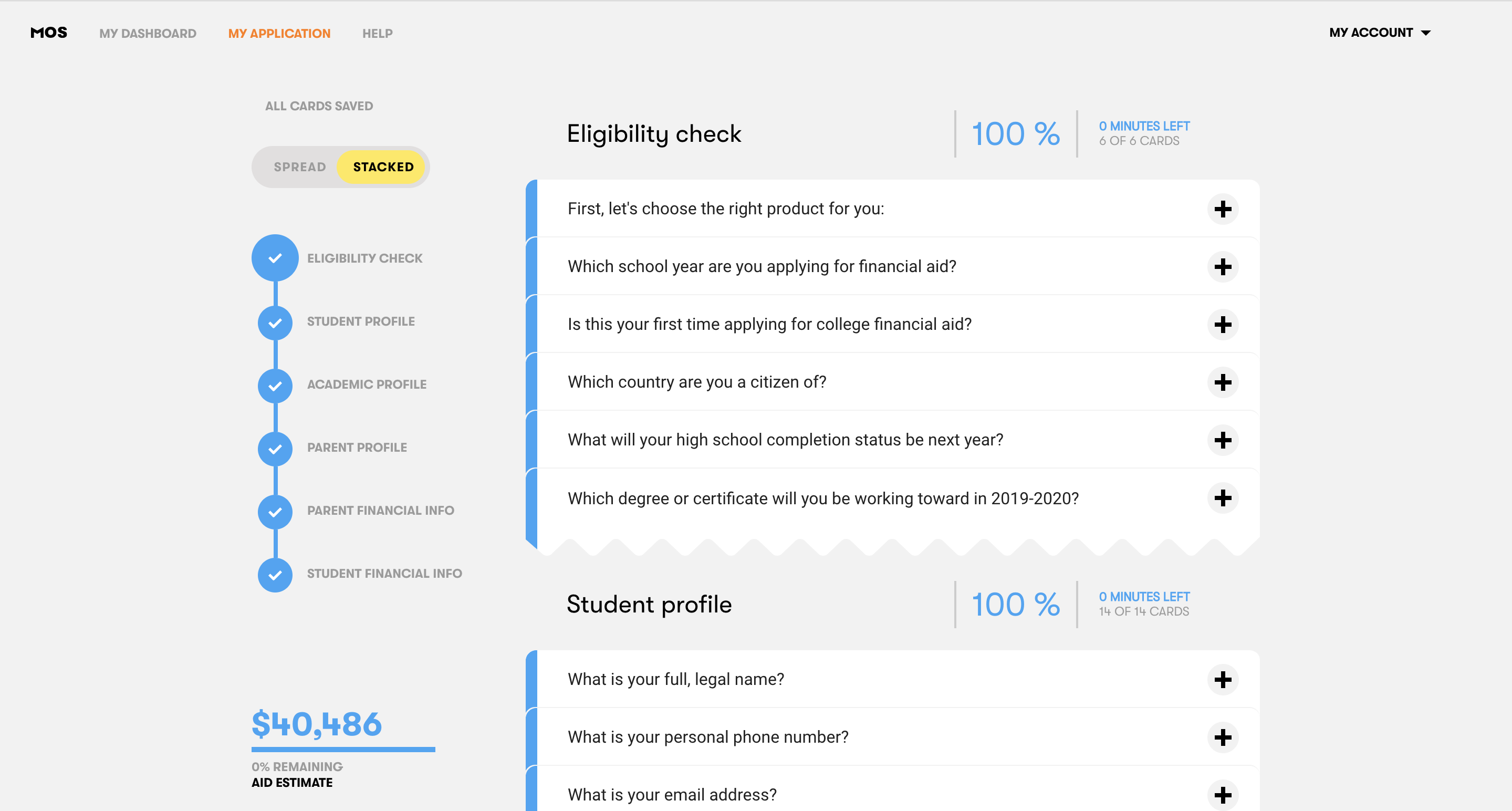
The Mos dashboard.
Mos is like if Turbo Tax married Typeform and had a baby, Yahyaoui explained. Not dissimilar to Common App, Mos lets students apply to more than 500 federal and state-based aid programs in minutes using a survey that matches them to every grant and scholarship program they qualify for, while simultaneously completing the FAFSA and state aid applications. To ensure every family is getting the most financial support possible, a Mos financial aid advisor reviews each case and negotiates with colleges for higher awards.
“Today, the biggest problem is people think they are not eligible for financial aid just because of how the thing is designed,” Yahyaoui said. “You’re supposed to just go ahead and fill a form that has 200 questions and then send it like a bottle in the sea and wait for months.”
Mos will complete a full-scale launch this summer and eventually tackle other nation’s college financial aid systems thanks to the new infusion of capital and the high-profile relationships Yahyaoui has forged in just one year living in the Bay Area.
Ultimately, it was Yahyaoui’s activism that granted her a ticket into the opaque world of Silicon Valley VC. As it turns out, angel investor Khaled Helioui, a fellow Tunisian immigrant in tech, was familiar with Yahyaoui’s work and when he heard she had relocated to the Bay Area to launch a technology startup, he wanted to know exactly what she was building. Today, he’s a Mos investor and board member and it was his introductions that helped Yahyaoui quickly and skillfully close her seed round.
An early angel investor in Uber, Helioui connected Yahyaoui with his friend Garrett Camp, the very wealthy co-founder and chairman of the ride-hailing giant, who was sold on Mos’s mission right off the bat.
“I think because Garrett is an immigrant, he knows what it is to suffer with bureaucracy,” Yahyaoui said. “He was a huge believer. He actually made it so easy for me because he said, okay, here’s an office, just stay and work.”
She was then introduced to John Doerr, the chairman of the esteemed VC firm Kleiner Perkins, known for his successful bets on companies like Google and Amazon. With Camp and Doerr on board, Mos didn’t struggle to raise additional capital; in fact, Yahyaoui was in an unusual position of being able to reject investors whose values and vision for Mos clearly didn’t align with hers.
Tearing down barriers

Yahyaoui, center, with the Mos team in San Francisco.
Yahyaoui isn’t in the startup business to get rich off students trying to navigate their way through the absorbently expensive process of applying to and attending college. She’s part of a growing class of founders out to prove that you can pair profits with good morals and lead venture-backed values-based businesses.
“I know if I created the same thing as an NGO, I could have already raised $100 million, but I like the accountability of business,” she said. “We can create businesses that are good for people.”
Yahyaoui’s story, from being exiled from her home country at a young age to fighting an authoritarian regime is not one that’s ever been told before in Silicon Valley.
In addition to being a trailblazing human rights advocate, she’s a woman, an immigrant, “uneducated” by Silicon Valley standards and a first-time tech founder that was able to walk into a meeting with John Doerr and walk out with a term sheet.
If she’s successful in building a global edtech business, she’ll be emblematic of the meritocratic culture The Valley has falsely claimed to uphold. Even if she’s not successful, she’ll have torn down barriers for other underrepresented founders and written a success story fitting for this new era of accountability in tech.
Powered by WPeMatico
Democratic senators question Juul about its Altria deal
Eleven democratic senators, led by Sen. Dick Durbin (D-IL), have penned a letter to Juul Labs, asking a series of questions around the product’s marketing, its effectiveness as a tool to help people quit smoking combustible cigarettes, sales figures and, perhaps most importantly, more information on the deal that gave Altria a minority stake in Juul Labs.
“The corporate marriage between two companies that have been the most prolific at marketing highly addictive nicotine products to children is alarming from a public health standpoint and demonstrates, yet again, that JUUL is more interested in padding its profit margins than protecting our nation’s children,” writes Sen. Durbin in the letter.
Questions in the letter include records around advertising and marketing spend for Juul products, as well as any changes that might have been made to Juul’s Youth Prevention Plan following the deal with Altria.
In late 2018, Juul announced it had sold a 35 percent minority stake of the company to Altria Group, makers of Marlboro cigarettes, for $12.8 billion. The company said that a partnership with Altria would help Juul market and distribute to currently addicted adult cigarette smokers.
In the letter, the senators cite the American Heart Association, which called the Altria/Juul deal “a match made in tobacco heaven.” Juul was already in hot water over its product’s popularity among young people, so it’s only expected that a partnership with traditional Big Tobacco would further fuel concerns among critics.
More from the letter:
JUUL’s decision to team up with Altria, the parent company of Philip Morris USA, is also bad news for children considering that Altria has a long and sordid history of spending billions to entice children to smoke through targeted campaigns that intentionally lied about the science and health effects from cigarettes. And their efforts have clearly paid off. According to the CDC, Altria’s Marlboro cigarette continues to be the most popular cigarette brand among children in the United States, with 48.8 percent of high school smokers preferring Marlboro cigarettes. Further, the proportion of high school smokers who smoked Marlboro cigarettes increased dramatically between 2012 and 2016, by a whopping 27 percent. While JUUL has promised to address youth vaping through its modest voluntary efforts, by accepting $12.8 billion from Altria—a tobacco giant with such a disturbing record of deceptive marketing to hook children onto cigarettes—JUUL has lost what little remaining credibility the company had when it claimed to care about the public health.
A Juul Labs spokesperson had this to say in response to the letter:
We welcome the opportunity to share information regarding JUUL Labs’ commitment to curbing underage use of our products while fulfilling our mission to eliminate combustible cigarettes, the number one cause of preventable death in our country. We agree that companies such as ours must step up with meaningful measures to limit access and appeal of vapor products to young people. That’s exactly what we’ve done, and we will do more to combat teen use to save the harm-reduction opportunity for the 34 million adult smokers in the United States. Don’t take our word for it — look at our actions. As part of our action plan deployed in November 2018 to keep JUUL products out of the hands of youth, we stopped the sale of certain flavored JUULpods to traditional retail stores, strengthened our retail compliance and secret shopper program, enhanced our online age-verification, exited our Facebook and Instagram accounts and are continuously working to remove inappropriate third-party social media content. We support the FDA’s draft guidance restricting the sale of certain flavored products, including JUULpods, at retail outlets and online, and will continue to work with FDA, Congress, state Attorneys General, local municipalities, and community organizations as a transparent and responsible partner in combating underage use.
U.S. Senators Patty Murray (D-WA), Ron Wyden (D-OR), Sherrod Brown (D-OH), Richard Blumenthal (D-CT), Jack Reed (D-RI), Elizabeth Warren (D-MA), Tom Udall (D-NM), Ed Markey (D-MA), Jeff Merkley (D-OR) and Chris Van Hollen (D-MD) joined Sen. Durbin in sending the letter. It comes just a month after the FDA proposed further regulations to the sale of flavored e-cig products.
Juul has until April 25 to provide answers and information in response to the letter.
Powered by WPeMatico
An Equity deep dive on Patreon
The popular TechCrunch podcast Equity this week launched a new series called Equity Dive, wherein a host interviews the writer of the latest edition of the Extra Crunch EC-1.
If you’ve ever wanted to know everything there is to know about Patreon, the platform that connects creators with fans and their wallets, then this is the show for you. TechCrunch Silicon Valley editor Connie Loizos speaks with Eric Peckham who spent hours upon hours meeting with the Patreon team to learn its origin story and the ins and outs of its business practices to get the company to where it is today.
As Eric says:
The way to think about how Patreon has evolved is I see it in kind of three stages, which was this initial crowd funding platform, and then evolving beyond that to try and be a destination platform for consumers where there would be great content that you just go to Patreon to find and you go to discover creators, kind of a marketplace model. They moved away from that. That was somewhat of a gradual shift and essentially the decision was it’s not good to be stuck in this game of trying to be yet another destination platform for consumers competing with YouTube and Instagram and every single media site out there. Really the opportunity and mission underlies our work is about helping creators and enabling all these independent creators to sustain themselves and to build thriving businesses.
They shifted, they now describe themselves as a SaaS company actually, which is very different from framing yourself as kind of a consumer destination. The long and short of it is they see this opportunity, which is a growing market of independent creators around the world who are building fan bases, and for that particular type of SMB they want to provide essentially the full suite of tools and services that they need to run their businesses.
For access to the full transcription, become a member of Extra Crunch. Learn more and try it for free.
Connie Loizos: Hi, I’m Connie Loizos and I’d like to welcome you to our first Equity Dive. Once a month we’re going to be dedicating an entire episode to a deep dive into the life of one company. This month I’m joined by Eric Peckham, who has reported extensively on the crowd funding membership platform Patreon. Hi Eric.
Eric Peckham: Hey Connie, excited to be here for the first Equity Dive.
Connie Loizos: Same, so Eric you and I ran into each other first in Berlin but we don’t know each other very well. I’d love to hear more about you. You’re based in LA, and from what I understand you are a media industry analyst. Is that correct?
Eric Peckham: Yes, so I cover through both my own newsletter Monetizing Media, the happenings of the global media and entertainment industry. It’s kind of a very business minded lens on media and entertainment.
Connie Loizos: Well I read your extensive coverage on Patreon and it was really impressive, and I wondered considering how much you wrote, is this sort of a long interest of yours this company or how did you decide to settle on this for your first deep dive for TechCrunch?
Eric Peckham: Yes, it was an exciting process digging into this. We made a short list of exciting companies, a lot of unicorn companies or late stage startups we thought were about to become unicorns, and Patreon jumped out for a number of reasons. One is as someone who runs his own newsletter I have had subscribers to that newsletter suggest creating a Patreon. I’ve looked into it before, so I had a little bit of a creator perspective of just wanting to better understand Patreon and other options in the market. I think from a bigger picture, more of a Silicon Valley perspective, Patreon’s a really fascinating company. They’ve raised over $100 million from top PC firms like Index, CRV, they’re the dominant player in this space they’re targeting, but it’s kind of them versus just the big social media platforms. There isn’t the startup that’s comparable in size to it and it’s really trying to own this whole territory of independent content creators, surveying them with different business tools or services.
Connie Loizos: It is really interesting to think the David and Goliath story involves a $100 million venture backed startup versus, as you say, I know these big players Facebook, YouTube. Let’s start at the beginning, so you decided on Patreon for reasons that I can certainly understand now. How did you set about pitching them on this idea? Because obviously you were going to need a lot of access to them, a lot of their time.
Powered by WPeMatico
Should you hire an in-house designer or a contractor?
Contributor
Editor’s note: This post is a part of our latest initiative to demystify design and find the best brand designers and agencies in the world who work with early-stage companies — nominate a talented brand designer you’ve worked with.
During a decade as the manager of the in-house design team at open-source technology company Red Hat, Chris Grams learned that brand design is best when informed by a company’s culture and community.
He felt a natural push toward an open, collaborative attitude, distinct from how many companies approached design at that time. It was the early 2000s, and most companies saw their interactions with customers as a one-way street. In open source, it was an intersection.
“You almost break down the company and the community of people who surround the brand,” says Grams, currently head of marketing at Tidelift, an open-source software management firm, and author of The Ad-Free Brand. “Now it feels like pretty standard operating procedure for the best brands that have the best relationship with their communities.”
This shift has a large influence on the question of when you should hire an in-house designer versus a contractor to do your branding design.
Three reasons to go in-house
After leaving Red Hat in 2009, Grams helped start New Kind, a branding agency that provides contract design services mostly to tech companies. This new vantage point allowed him to see drawbacks and advantages for companies in outsourcing design versus bringing it in-house.
One of the key benefits of in-housing is the designer’s intimacy with the deeply held values and culture of the company, which makes their branding work feel more authentic.
“The internal agency’s power really reveals itself when people are deeply part of the mission of the company,” says Grams. “It comes through in the work. You get an amazing work product.”
The second benefit, especially for tech companies, is the depth of understanding in-house designers can develop about the company’s products and services. And the third is that a dedicated in-house designer can be directed as needed to respond to pressing priorities.
“You can have them stop on a dime,” says Grams. “Say a competitor comes out with a big launch and you need to have something out within 24 hours. You can work on it right away.”
These are real benefits, but they may not outweigh the advantages of contracting out your design to a high-quality agency.
The benefits of using an agency
A major benefit of an agency is that you can hire people with a level of expertise and variety of skills that would be out of reach for an in-house team. When Grams was at New Kind, for example, “we had a combined 30 years of experience with open-source branding work,” he says.
An agency can also provide the bandwidth to take on non-priority tasks such as a rebrand or a special series that in-house teams are often too work-strapped to take on.
Hiring an agency also has advantages in terms of flexibility and cost. The ability to customize the timing and amount of design work to your needs can be less expensive over time, even if each working hour is more expensive.
“You can ramp down and ramp up with an agency,” says Grams. “It’s impossible to do that with people… You’re paying that extra margin to have that flexibility.”
There’s a lot to think about, but Grams advises prioritizing the need for your design to be authentic to your culture… or not.
“I think the biggest thing is the power of your culture, frankly,” says Grams. “If you have a company where culture is not an asset, I would not build an in-house design team… But if you’re building a mission-driven organization or an organization where culture is super important, that’s where I would take an extra-long look at building an internal agency.”
Powered by WPeMatico


